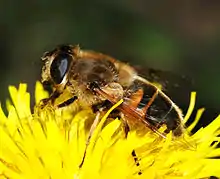Eristalini
Eristalini is a tribe of hoverflies. Several species are well-known honeybee mimics, such as the drone fly Eristalis tenax, while other genera such as Helophilus and Parhelophilus exhibit wasp-like patterns of yellow and black stripes, both strategies to avoid predation by visual predators such as birds.
| Eristalini | |
|---|---|
 | |
| Eristalis tenax | |
| Scientific classification | |
| Kingdom: | Animalia |
| Phylum: | Arthropoda |
| Class: | Insecta |
| Order: | Diptera |
| Family: | Syrphidae |
| Subfamily: | Eristalinae |
| Tribe: | Eristalini |
| Subtribes | |
| |
They breed in decaying organic materials such as run-offs from dung heaps (Eristalis) or in ponds and ditches (e.g. Anasimyia). Some others, such as Myathropa and Mallota, breed in wet rotting tree stumps and rot holes.
A characteristic feature of this tribe is the "rat-tailed maggot" with a rear positioned telescopic breathing tube, allowing the larvae to breathe while living submerged in water or mud. This feature is also shared with another hoverfly tribe the Sericomyiini though those flies do not share the characteristic eristaline dip in wing vein R4+5.[1]
List of genera
Thompson[2] considers the tribe Sericomyiini a subtribe of the Eristalini while others separate it.
|
Subtribe: Eristalina[2]
|
Subtribe: Helophilina[3]
|
References
- Alan E. Stubbs & Steven J. Falk (1983). British Hoverflies: An Illustrated Identification Guide (2nd ed.). London: British Entomological and Natural History Society. pp. 284–300. ISBN 1-899935-03-7.
- F. Christian Thompson (2003). "Austalis, a new genus of flower flies (Diptera: Syrphidae) with revisionary notes on related genera" (PDF). Zootaxa. 246: 1–19. ISSN 1175-5326. Archived from the original (PDF) on 2010-01-23.
- F. Christian Thompson (2000). "A new genus of Australasian Flower Flies (Diptera: Syrphidae)" (PDF). Studia Dipterologica. 7 (2): 373–384. ISSN 0945-3954.